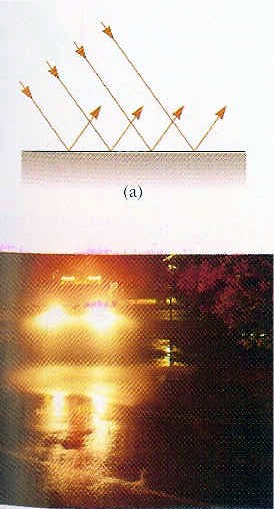
Physics Of Optics
While investigating the use of fiber optic technology, it is important to understand the fundamental rules of optics. Some of the leading scientists of their time viewed light from two main perspectives. Some believed that light behaved according to the characteristics of wave forms, still others believed in a theory of corpuscles, which was inspired by the Greeks.
For our purposes, we will only investigate a few of the properties of light and its behavior. One significant behavior, which is critical to the field of optics is REFLECTION.

Physics for Scientists and Engineers, fifth edition
SPECULAR REFLECTION is the projection of light off of a smooth surface and the rays of light occurr parallel to each other.

Physics for Scientists and Engineers, fifth edition
DIFFUSE REFLECTION is the projection of light off of a rough surface where the rays of light are not parrallel.

Physics for Scientists and Engineers, fifth edition
LAW OF REFLECTION is the premis, which states that the angle of incidence is equal to the angle of reflection.

Physics for Scientists and Engineers, fifth edition
INDEX OF REFRACTION is unique to materials. It is the ratio of the speed of light in a vacuum to the speed of light in a medium. As light travels between mediums, the frequency remains the same, while the wavelength does not. This creates a change in velocity of the light. This change in velocity between mediums produces the "bent" light phenomena, where an object can appear disjointed when viewed between two mediums.
n= Speed of light in a vacuum/ Speed of light in a medium= c/v
SNELL'S LAW gives us the ability to quantify the changes in indicies of refraction between two adjoining mediums
n1 sinø 1= n2 sinø 2

www.howstuffworks.com/fiber-optic.htm
TOTAL INTERNAL REFLECTION occurs only when light passes from a medium with a higher index of refraction to a medium of lower index of refraction. It is also important that the angle of reflection is within the proper parameters. This is called the critical angle of total internal reflection.
CRITICAL ANGLE OF TOTAL INTERNAL REFLECTION is a point in which some of the light travelling in a given medium is reflected within that medium. None of that llight escapes the medium.
Sin øc = n2/n1, where n1>n2
FERMAT'S PRINCIPLE states that when light travels between points, its path is the one which occurrs in the least amount of time.
| 1 2 3 4 5 6 7 8 9 10 11 | Next >> |